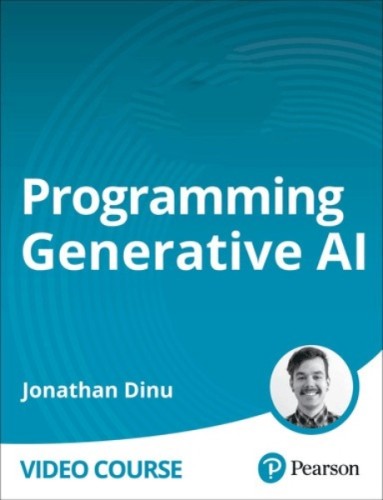Programming Generative AI

Released 10/2024
MP4 | Video: h264, 1280x720 | Audio: AAC, 44.1 KHz, 2 Ch
Genre: eLearning | Language: English | Duration: 18h 16m | Size: 4.1 GB
From variational autoencoders to Stable Diffusion with PyTorch and Hugging Face.
Overview
Programming Generative AI is a hands-on tour of deep generative modeling, taking you from building simple feedforward neural networks in PyTorch all the way to working with large multimodal models capable of simultaneously understanding text and images. Along the way, you will learn how to train your own generative models from scratch to create an infinity of images, generate text with large language models similar to the ones that power applications like ChatGPT, write your own text-to-image pipeline to understand how prompt- based generative models actually work, and personalize large pretrained models like stable diffusion to generate images of novel subjects in unique visual styles (among other things).
About the Instructor
Jonathan Dinu is currently a content creator and artist working with deep learning and generative AI. Previously, he was a PhD student at Carnegie Mellon University before dropping out to ultimately pursue the less academic and more creative side of machine learning. He has always loved creating educational content, going back to his days as a co-founder of Zipfian Academy, an immersive data science bootcamp, where he had the opportunity to run workshops at major conferences like O'Reilly Strata and PyData, create video courses, and teach in person.
Skill Level
Intermediate to advanced
Learn How To
Train a variational autoencoder with PyTorch to learn a compressed latent space of images
Generate and edit realistic human faces with unconditional diffusion models and SDEdit
Use large language models such as GPT2 to generate text with Hugging Face Transformers
Perform text-based semantic image search using multimodal models such as CLIP
Program your own text-to-image pipeline to understand how prompt-based generative models such as Stable Diffusion actually work
Properly evaluate generative models, both qualitatively and quantitatively
Automatically caption images using pretrained foundation models
Generate images in a specific visual style by efficiently fine-tuning Stable Diffusion with LoRA.
Create personalized AI avatars by teaching pretrained diffusion models new subjects and concepts with Dreambooth.
Guide the structure and composition of generated images using depth- and edge- conditioned ControlNets
Perform near real-time inference with SDXL Turbo for frame-based video-to-video translation
Who Should Take This Course
Engineers and developers interested in building generative AI systems and applications
Data scientists interested in working with state-of-the-art deep learning models
Students, researchers, and academics looking for an applied or hands-on resource to complement theoretical or conceptual knowledge they may have.
Technical artists and creative coders who want to augment their creative practice
Anyone interested in working with generative AI who does not know where or how to start
Course Requirements
Comfortable programming in Python
Knowledge of machine learning basics
Familiarity with deep learning and neural networks will be helpful but is not required

https://ddownload.com/974tevw0l7qo
https://ddownload.com/llefouszzns7
https://ddownload.com/vv2rxi8xzr91
https://ddownload.com/c1n3wml9i600
https://ddownload.com/58fgghwnq6e5
https://rapidgator.net/file/9c5547f73f4e2e430a214b4b781401ce
https://rapidgator.net/file/7eb9b2cdd9fafee7c0e56f32d81ee77e
https://rapidgator.net/file/3e7b56586ea8b58be862b51b2735234a
https://rapidgator.net/file/86538111c53f3111063529121393fa73
https://rapidgator.net/file/605e847592590344f8cfd1180d130586